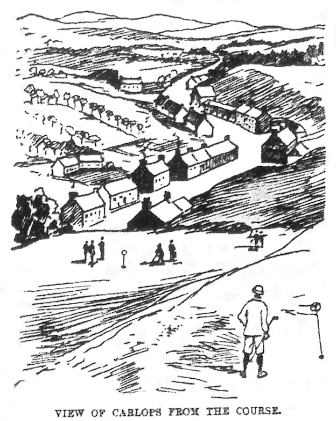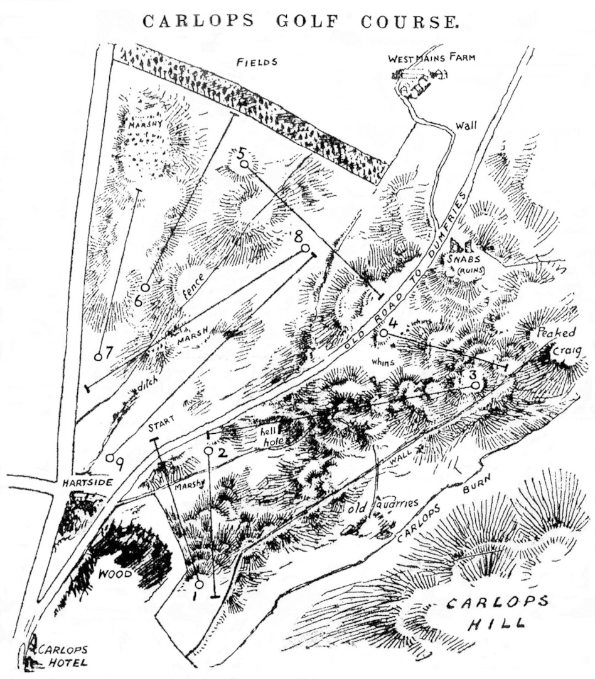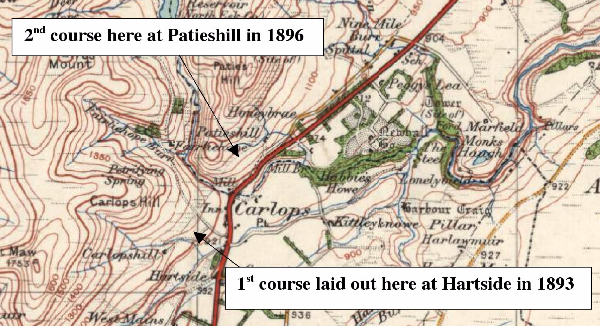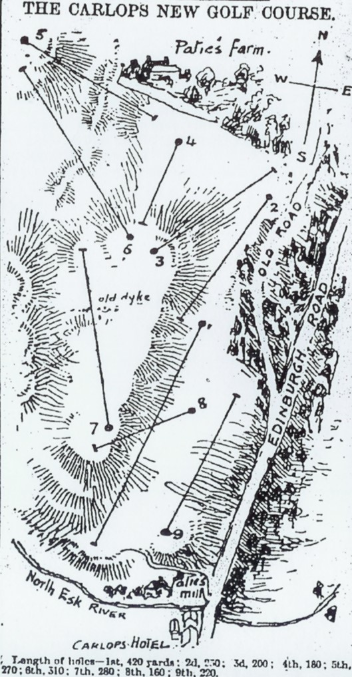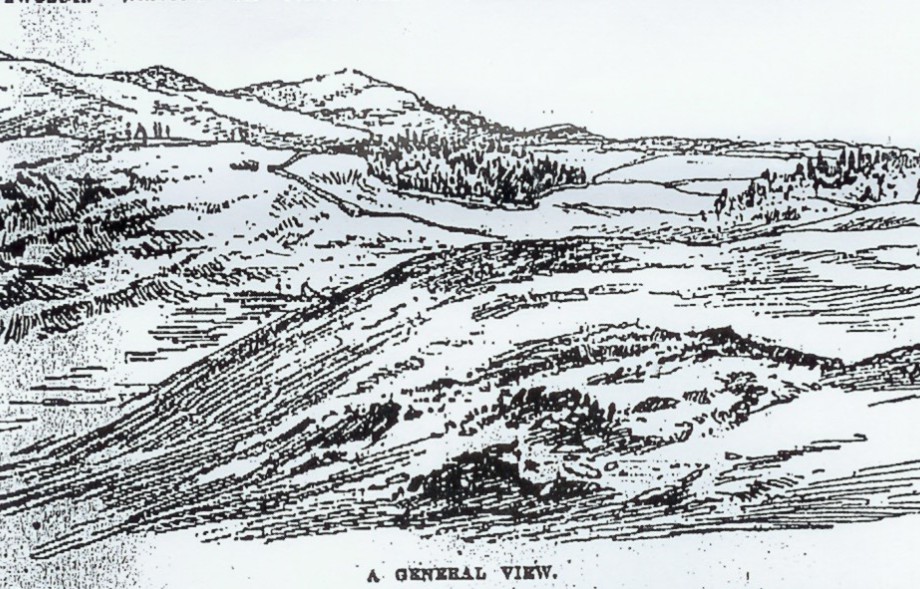
Carlops
Habbie’s Howe and Carlops Golf Club. Instituted 1893. A 9-hole course on West Mains Farm, the 1st tee is near the Allan Ramsey hotel. Laid out by Willie Park, the course is a mile and a half long with bunkers whins and heather as hazards.
Carlops Golf Course
"It is becoming more and more recognised that no health resort is complete without it’s golf course. Carlops, long famous for it’s rural beauties and invigorating atmosphere, and still more for it’s undying associations with Alan Ramsay’s “ Gentle Shepherd “ has added to it’s attractions – great as these already are – for visitors by the acquisition of a golf course of nine holes. While keen golfers do not when following the game pay much attention to scenery – indeed, one high authority has it that the player who gives way to the temptation to admire beautiful land or sea scapes ends the round usually several holes down – still for visitors seeking health, a quiet game amid charming surroundings furnishes unalloyed enjoyment. In this respect the Carlops course will be an ideal one : and the promoters of it are to be congratulated upon their wisdom in keeping abreast of the times.
The course is situated at the foot of the Pentlands, within a few minutes walk of Carlops Hotel. For the first four holes the ground is of a rugged nature, but the next fife are placed on less rough and more undulating ground. There are plenty of natural hazards to satisfy the most exacting golfer. To the first hole, where the line of play lies in a northernly direction, a valley has to be crossed and a steep slope has to be climbed before the putting green is reached : and a sliced drive from the tee will land the ball over a wall in bad country to the right. The second is in the opposite direction, and down the slope, where, if the play be not straight, a marsh to the left will prove a formidable hazard. The third hole is of considerable lengh. It is indeed, the second longest, and the most difficult hole on the course. The line of play is over a series of hills and valleys and are not far from the tee. To the right and left of the topped drive will land in “ Hell’s Hole” a deep gully green, careful play is necessary, as there are whins and sand holes to encounter : and there is a possibility too of the ball rolling down the other side should the green be passed. In playing to the fourth hole, there is nothing to interfere with the drive – which is a cleek stroke – but at each side of the green there are whins and a rough road to trap a ball, should the green be overrun.
At the fifth there is a fence to cross, otherwise the player has no hazard to contend with, unless the driving be much out of line, when a ditch and marshy ground may prove troublesome. The ground is marshy in front of the tee at the sixth hole, but it is comparatively level, and a good drive should land within easy pitching distance of the green. The next hole shares the characteristics of that preceeding . In driving to the eighth, a marsh and fence have to be crossed.
A clean stroke will clear both, and leave no other obstruction between the player and the hole. The last is the longest on the green. Here it is all plain sailing, staight driving being all that is required to make it a good hole. The turf for the greater part of the course is natural, and excellent for the purpose of golf. At the lower part, near the main road, which is at present being drained, it is comparatively new and shows signs of becoming all that agolfer can desire. The putting greens, with the careful attention they are receiving, will at no distant date be in admirable trim, and in keeping with the attractive nature of the course.
Those who visit the spot will find, when they have persued their favouite game to the full, abundance to interest them in the picturesque and interesting environments of the green. For example, there is the Allan Ramsy Hotel, where the proprietrix maintains the best traditions of the Scottish country hostelry : The beautiful falls of the Esk at Patie’s Mill, and, peculiarly interesting in those days, when mechanical means have taken the place of former methods, Hartside Cottage, where the old handloom may still be senat work. The green, which will be the headquarters of the Habbie’s Howe and Carlops Club, is to be formally opened for play on the 6th June." (EED 6.5.1893)
“The course which has been laid out at Carlops was formally opened yesterday. Consisting of nine holes, this course is situated in a picturesque valley a few minutes walk in a southerly direction from the village of Carlops, and being at the southern end of the Pentland range, is overlooked by the Maw and Carlops hils, the better known peaks of the Pentlands closing in the view to the northward. Though at present the ground is in a rough state, it is admirably adapted for the Royal and Ancient game. One thing only is wanting, and that is the laying out of the putting greens in the orthodox fashion. As was appropriately said yesterday by competent authorities, the ground selected has the makings of an excellent course, and with the requisite amount of play, care and attention, the round of nine holes will undoubtedly become a really playable one.
The first teeing ground is on the edge of the old road to Dumfries, The line of play, in a northerly direction, is across a short marshy valley, which with the slope beyond, provide a hazard likely to be avoided by careful players. The putting green is on an elevated plateau, and the distance to the hole is some 180 yards. The second hole is placed at the southern end of the valley, and measures about 140 yards. No great difficulty is encountered here, and the hole is an easy 4. The third hole is, perhaps, the most difficult in the green, and is well named “ Hell’s Hole” A deep gorge on the right, with a marshy bottom, provides condign punishment to the player who tops or draws his ball, while on the left a heathery bank is almost equally disastrous. Even with a good drive the lie for the second stroke is critical, and a good second stroke may land the ball in a dangerous nest of whins. Still, with two good strokes, and an iron pitch the hole may be had in 5. The approach to the next hole is an easy cleek shot, and though on either side heather and whins have to be negotiated, the hole, with careful play, is an easy 4. A topped ball, in driving for the fifth hole, will give the player an amount of work to get clear of a nasty bog. A clean stroke will land the ball within easy pitching distance of the hole, which may likewise be had in 4. The approach to the next two holes is marred by numerous tufts of bent, while the line to the eighth hole is across a bog which may become a source of innumerable lost balls. The ninth hole, though the longest on the course, being some 380 yards in length, is comparatively easy, though with a drawn ball the player may find himself in considerable difficulties.
Yesterday between forty and fifty gentlemen drove out from Edinburgh to take part in the opening game. Captain Tweedie, the patron of the club, drove off the first ball amid a round of hearty cheering. Thereafter, the members of the club, who number twenty, and their friends engaged in a variety of singles and foursomes. The most interesting foursome was that between Willie Park and G Blair, Musselburgh, and Mr H Craigie, of the Braids, and J Murray, Musselburgh. Two rounds of the green showed that the former were heavier metal than the their opponents, the ex – champion and his partner landing five up on the match. In the afternoon Park and Mr G.B.Paterson played Messrs J Murray and J.W.Paterson, and won by four holes. The best individual score was made by Dt Woodhead, his total of 43 for the nine holes being gained by excellent golf. Mr J.W.Paterson did the round in 44. At the dinner, which was held in the Allan Ramsay Hotel, Captain Tweedie occupied the chair. He proposed the usual loyal and patriotic toasts, Mr Sinclair replying for the military services. Mr Magnus Taylor proposed the toast of the Habbies Howe and Carlops Golf Course, and in doing so referred to the delightful outing the company had enjoyed, and to the enterprise which had characterised the villagers and others in furnishing so promising a golf course. He was sure that as time went on the course would be appreciated by golfers more especially as the Braids and other courses near Edinburgh were becoming inconveniently crowded. Mr James Stevenson proposed the health of Mrs Veitch, the proprietrix of the hotel, and spoke in appropriate terms of her kindness and hospitality.
Mr J.B.Veitch replied to both toasts, and while acknowledging the kindness of that reference to himself and the proprietrix of the hotel, expressed the hope that they would ever be found ready, as they were always willing. To meet the wishes of visitors, to cater for their comfort, and to provide everything in the shape of outdoor exercise and amusement which would maintain and extend the reputation of the Carlops. After an extremely enjoyable day, the party returned to Edinburgh in the evening."
(EED 7.6.1893)
This course closed in 1895. In 1896 a new 9 hole course was opened on Cloverhill Farm, a mile and a half along the Edinburgh road, bounded on the east by the North Esk river.
New Course
"The old course of the Habbie’s Howe and Carlops Golf Club has not proved a success, owing to the stony and rugged nature of the ground, and accordingly, the committee, with the assistance of the Hon. Secretary, Mr T.B.Veitch, have acquired a new site for their green. The new course, which is one of nine holes, is situated onPatie’s Hill, at the base of the pentlands, and within a stones throw of Carlops Hotel. The turf is natural, although at some parts rough, butwith a little cutting here and there it should soon become excellent for the purposes of golf. A few hazards will have to be made to give additional interest to the game.The first and last two holes are placed on a gentle slope on the lower part of the hill, while the others are distributed higher up ona plateau. The line of play to the first hole lies in a northernly direction, and the ground rises gradually until the hole is reached. The second hole is in the same direction, but a sliced drive from the tee here will land the ball over an embankment and on to an old road in bad country to the right. The third lies on top of a hill, the hole being hidden from the tee. The fourth is a short hole, and there is no obstacle to face before reaching the green. The fifth lies across a valley and up a slope on the other side. A bunker could be placed here to great advantage. The sixth has the same characteristics as the fifth. The seventh is along the top of the ridge. A sunken dyke might trap some drives at this hole, but the majority of players carry it. The green is well placed in a hollow. This is the highest part of the course, being over 1000 feet above sea level, and a splendid view of the surrounding country is obtained. The eighth is a full iron stroke to the valley beneath, and the ninth is over level ground. There is plenty of room for lengthening the holes and laying down hazards. The course is to be opened with an amateur tournament next month"
(EED 28.5.1896).
Advert in the Scotsman June 1st 1896.
"Carlops Golf Club : - This club’s new green will be opened by an Amateur tournament ( Handicap ) on Thursday the 18th June. Five prizes. Coaches leave Waterloo Place at 9 o’clock : Return fare 2s 6d. Entry money 2s 6d. Forms from the secretary, Mr J.B.Veitch, Hotel, Carlops." (Advert in Scotsman 1.6.1896)
"Carlops Golf Club : - This club’s new green will be opened by an Amateur tournament ( Handicap ) on Thursday the 18th June. Five prizes. Coaches leave Waterloo Place at 9 o’clock : Return fare 2s 6d. Entry money 2s 6d. Forms from the secretary, Mr J.B.Veitch, Hotel, Carlops." (Advert in Scotsman 1.6.1896)
Length of holes
1st, 420 yards, 2nd, 250 yards, 3rd, 200 yards, 4th, 180 yards, 5th, 270 yards, 6th, 310 yards, 7th, 280 yards, 8th, 160 yards, 9th, 220 yards.
“The Scots king who regarded the ingathering of the harvest at Carlops as an index of plenty in the kingdom would doubtless have derived satisfaction from the proceedings which took place there yesterday. A year or two ago, to the south of the village, a course was formed where deep ravines formed exciting hazards. With a quickened sense of the limits of human endurance in the matter of play, the club looked out for a fresh course, and found one to the north of the village. Bounded on the east by the north Esk river which is here near it’s fountain head, the remaining area may be said to be included in the triangle formed by the turnpike road and right of way leading by Spittal towards Ninemileburn. The ground has been laid out in nine holes, and the grass having been carefully attended to, much good play may be expected. The distance from a railway station mitigates somewhat against it’s prospects; but on the other hand, the presence yesterday of many well – known players from Edinburgh and Provincial clubs shows that it is not without considerable merits. Forty-five gentlemen entered for the opening game, and in a pleasant little speech, Lieutenant Colonel John Tweedie, R.N. Declared the green opened. He referred to the arrangements made by the club, by virtue of which for the modest subscription of 5s, a twelve months amusement could be obtained. After several hours play, the winners in the amateur competition were found to be as follows : - First Prize, John Mobray, West Linton 82 : 2nd, A Kerr, Braids 84 : 3rd, Dr A.E.Watson, Wemyss 85 : 4th, R Wooley, Licensed Victuallers 86 : 5th, J Richardson, Glencorse 90. The other leading scores were: - J Duncan, Rutherford House 91 , R Veitch , 91, H.J.Stuart Carlops and Baberton 91.” (S 19.6.1896).
The annual subscription was 5/- but, unfortunately, due to a lack of a local population and its distance from a railway station, the club failed to flourish. (WLGC). 30 members.
